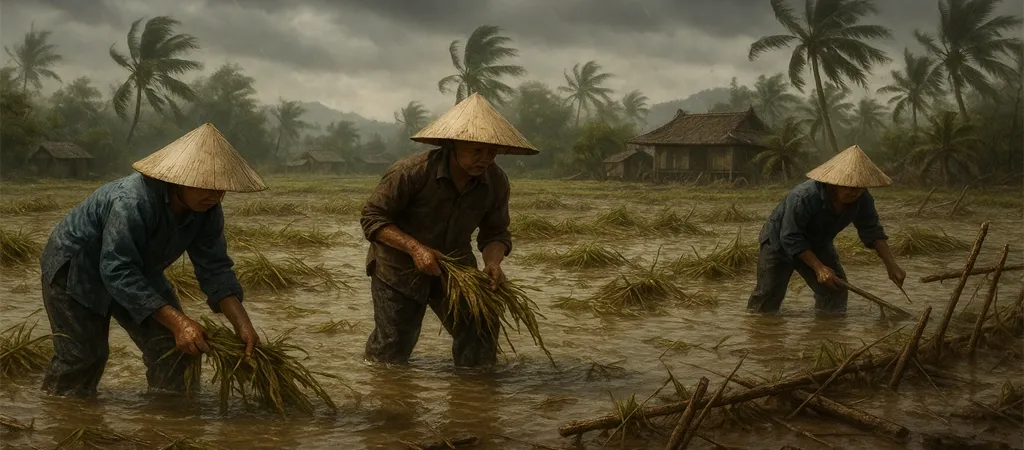
The global pistachio market is entering a tighter phase in the 2025/26 season. While the United States delivered a record harvest, sharp downward revisions in Iran and Turkey have pushed total global production lower than last year. According to the

Government response includes emergency relief, seed and fertilizer mobilization, and sanitation protocols, though seed reserves fall short of demand. Efforts to rehabilitate production zones and launch flood-resilient planting are underway, while universities and community groups support cleanup and disease mitigation efforts. It is a crucial moment for individuals engaged in investments, export, and agritech. Vietnam must accelerate the development of new seeds, flood-protection technologies, innovative concepts in fish farming, and land transfer regulations to scale up larger companies.
Vietnam issued an emergency warning for coastal provinces such as Quang Ninh and Ninh Binh as Typhoon Wipha closes in on the nation. The typhoon will strike the coast, resulting in heavy rain, flash flooding, and landslides. The storm has disrupted the rescue operation in regards to a tourism boat collision at Halong Bay.
As Typhoon Wipha approaches, local and international flights have been grounded, disrupting travel and supply chains across the region. Authorities have initiated widespread evacuations to protect residents in vulnerable coastal and low-lying areas. All maritime vessels, including fishing boats and cargo ships, have been ordered to return to port, and emergency communication systems are being reinforced.
These drastic measures, while necessary for safety, are severely impacting farming communities—especially those reliant on steady transport for exporting rice and other crops. Delays in moving produce, accessing markets, or receiving agricultural supplies threaten the livelihood and resilience of already fragile rural economies.
Flooding triggered by Storm Wutip drenched the Dai Loc District in Quang Nam, normally prone to seasonal flooding. Over 4,000 houses across multiple communes were submerged under a meter of water. Roughly 16,700 hectares of crops were damaged, including 4,000 hectares of rice, and fields of corn, beans, sesame, and watermelons were buried under thick mud. Many farmers, facing sudden devastation, lost nearly all their planted crop yields days before harvest.
Their bean, sesame, watermelon, or corn fields had been uprooted, destroyed, or burned down.
Peanut and vegetable plots are abandoned to rot, even when they are near maturity.
Estimated economic loss in key regions varies between VND 30 million per small grower (around USD 1,200) to several times that at the district scale.
In northern Vietnamese provinces of Bac Giang and Thai Nguyen, farm animals as well as chickens were transferred to safety in Tip-tops.
One farm lost 20,000 chickens (approx. VND 3 billion loss). Local students and agricultural faculty assisted with cleanup and disinfection, supported by authorities. Health risks linger as carcasses and mud persist.
When the damage to the crop worsened, the Ministry of Agriculture and Rural Development (MARD) of Vietnam immediately made efforts to stabilize the produce as well as aid farmers in distress.
It realized that something had to be done and spoke with local farmer groups in order to obtain further rice seeds and fertilizers. At present, the nation requires 15,000 tons of seeds, yet now only has 4,000 to 5,800 tons, something that represents a huge gap.
Local authorities agreed to allow farmers to use fast-maturing seeds that take 90 days to mature. These are fast-maturing varieties that enable farmers to grow food early in the cold season, conserving food stocks and minimising wastage. Regions that would tend to experience poor food output, in particular Nam Dinh, benefited the most from the seeds. Recently, Hue City received 160 tonnes of seeds such as Khang Dan 18 and Huong Thom 1 in a bid to support the region.
Rice seeds were distributed alongside fertilizers. Farmers got organic fertilizer as well as chemical fertilizers, such as urea and NPK compound fertilizer, which are essential for rice. By doing this, farmers would no longer need to incur additional expenses to purchase them elsewhere.
It is crucial to clean up after the flood and prevent diseases. Farmers were instructed to adequately drain the fields and disinfect with ring-root disease and seedling blight prevention. Poultry pens, in particular bird pens, were cleaned in order to battle germs and fungus in damp places. Local universities and farm groups collaborated, and they were assisted by doing door-to-door distribution of lime and bleach.
Implementing biosecure cleanup helps farmers’ livelihoods rebound, too—livestock and poultry losses risk a wave of zoonotic diseases (e.g., bird flu, Newcastle disease) in hot, wet environments. Coordinated disinfection and disposal protocols have been rolled out.
When the floodwater recedes, the authorities are providing lime and disinfectants to clean up barns and fields.
* Animal cleaning and health are of concern in preventing disease epidemics, with consultations from agricultural universities.
* Vietnam’s Mekong Delta faces rising salinity and sea-level threats, expected to flood nearly 47% of its area by 2050, disrupting its role as the rice bowl.
Large temperature rises and irregular rainfall intensify heatwaves and droughts, damaging food security.
* Small-scale farms struggle with fragmented landholding due to outdated land limit regulations, making investment in modern agriculture difficult. Reform is needed to scale operations with consistent inputs and mechanization.
Vietnamese agriculture has witnessed grave issues posed by nature over the past week. Typhoon Wipha and preculminating rains by Storm Wutip triggered flooding in several regions, damaging key agriculture zones. Rice, maize, watermelon, and sesame crops are lying flat or uprooted by mud; in several instances, the fields are lying vacant.
Poultry farming has experienced issues as well: lots of the chickens perished, leaving farmers with severe money problems, and now concern about disease looms large.
Mekong Delta, highly relevant to Vietnam’s exports of rice and seafood, has issues with increased salt concentrations and unpredictable weather. It also has fragmented land, making modernization of the farm sector and investment a challenge.

